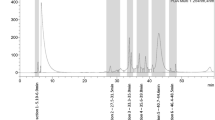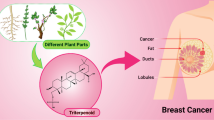Abstract
In this study, we investigated the effects of 2,3,6-tribromo-4,5-dihydroxybenzyl methyl ether (TDB), isolated fromSymphyocladia latiuscula (marine red algae), on the proliferation of MCF-7 human breast cancer cells. TDB treatment for 48 h inhibited cancer cell growth and induced DNA fragmentation. Furthermore, morphological characterizations such as apoptotic bodies and membrane blebs were shown by electronic microscopy. TDB-induced apoptosis in the MCF-7 cells was closely linked with the down-regulation of Bcl-2 protein expression and the cle⇑age of caspase-3 substrates, with poly(ADP-ribose) polymerase cleavage occurring by TDB treatment. TDB treatment also caused a marked increase in the level ofp21 WAF1/CIP1 protein in a p53-dependent manner. In addition, the upregulation ofp21 WAF1/CIP1 in the MCF-7 cells was related to a decrease in c-Myc protein in a dose-dependent manner. Based on our data, TDB is a good candidate for further evaluation as an effective chemotherapeutic agent, acting through the induction of apoptosis.
Similar content being viewed by others
Reference
Bange J., Zwick E., and Ullrich A., Molecular targets for breast cancer therapy and prevention.Nat. Med., 7, 548–552 (2001).
Baselga J. and Mendelsohn J., The epidermal growth factor receptor as a target for therapy in breast carcinoma.Breast Cancer Res. Treat, 29,127–138 (1994).
Choi, H. J., Kim, H. H., Lee, H. S., Huh, G. Y, Seo, S. Y, Jeong, J. H., Kim, J. M., and Yoo, Y. H., Lactacystin augments the sulindac-induced apoptosis in HT-29 cells.Apoptosis, 8, 301–305 (2003).
Choi, H. J., Choi, Y. H., Yee, S. B., Im, E., Jung, J. H., and Kim, N. D., lrcinin-1 induces cell cycle arrest and apoptosis in SK-MEL-2 human melanoma cells.Mol. Carcinog. 44, 162–173 (2005).
Choi, H. J., Yee, S. B., Park, S. E., Im, E., Jung, J. H., Chung, H. Y, Choi, Y. H., and Kim, N. D., Petrotetrayndiol A induces cell cycle arrest and apoptosis in SK-MEL-2 human melanoma cells through cytochrome c-mediated activation of caspases.Cancer Lett.. 232, 214–225 (2006).
Chung, H. Y., Choi, H. R., Park, H. J., Choi, J. S., and Choi, W. C., Peroxynitrite scavenging and cytoprotective activity of 2,3,6-tribromo-4,5-dihydroxybenzyl methyl ether from the marine algaSymphyocladia latiuscula.J. Agric. Food Chem., 49,3614–3621 (2001).
Dermers, G. W., Foster, S. A., Halbert, C. L., and Galloway, D. A., Growth arrest by induction of p53 in DNA.Proc. Natl. Acad. Sci. USA, 91, 4382–4386 (1994).
Dipaola, R. S. and Aisner, J., Overcoming bcl-2 and p53 mediated resistance in prostate cancer.Semin. Oncol., 26,112–116 (1999).
Fesik, S. W., Promoting apoptosis as a strategy for cancer drug discovery.Nat. Rev. Cancer, 5, 876–885 (2005).
Finucane, D. M., Wetzel, E. B., Waterhouse, N. J., Cotter, T. G., and Green, D. R., Bax-induced caspase activation and apoptosis via cytochromec release from mitochondria is inhibitable by Bcl-xL.J. Biol. Chem., 214, 2225–2233 (1999).
Gartel, A. L. and Radhakrishnan, S. K., Lost in transcription: p21 repression, mechanisms, and consequences,Cancer Res., 65, 3980–3985 (2005).
Gross, A., MacDonnell, J. M., and Korsmeyer, S. J., Bcl-2 family members and the mitochondria in apoptosis.Genes Dev., 13, 1899–1911 (1999).
Hartwell, L. H. and Kastan, M. B., Cell cycle control and cancer.Science, 266,1821–1828 (1994).
Harris, M. H. and Thompson, C. B., The role of the Bcl-2 family in the regulation of outer mitochondrial membrane permeability.Cell Death. Differ., 7,1182–1191 (2000).
Hengartner M. O., The biochemistry of apoptosis.Nature (London), 407, 770–776 (2000).
Hsu Y L, Kuo P. L., Lin L. T., and Lin C. C., Asiatic acid, a triter- pene, induces apoptosis and cell cycle arrest through activation of extracellular signal-regulated kinase and p38 mitogen- activated protein kinase pathways in human breast cancer cells.J. Pharmacol. Exp. Then, 313, 333–344 (2005).
Im, E., Choi, S., -H., Suh, H., Choi, Y. H., Yoo, Y. H., and Kim, N. D., Synthetic bile acid derivatives induce apoptosis through a c-Jun N-terminal kinase and NF-êB-dependent process in human cervical carcinoma cells.Cancer Lett., 229, 49–57 (2005).
Juin, P., Hueber, A. O., Littlewood, T., and Evan, G., c-Myc- induced sensitization to apoptosis is mediated through cytochromec release.Genes Dev., 13,1367–1381 (1999).
Li, Y., Ahmed R, Ali S., Philip P. A., Kucuk O., and Sarkar F. H., Inactivation of nuclear factor kappaB by soy isoflavone genistein contributes to increased apoptosis induced by chemotherapeutic agents in human cancer cells.Cancer Res., 65, 6934–6942 (2005).
Lacroix, M., Toulon, R. -A., and Leclercq, G, p53 and breast cancer, an update.Endocr. Relat. Cancer, 13,293–325 (2006).
Leppäd Bohmann, D., Diverse functions of JNK signaling and c-Jun in stress response and apoptosis.Oncogene, 18, 6158–6162(1999).
Mayer A. M. and Gustafson, K. R., Marine pharmacology in 2000: antitumor and cytotoxic compounds.Int. J. Cancer, 105,291–299(2003).
Mitchell, K. O. and El-Deiry, W. S., Overexpression of c-Myc inhibitsp21 WAF1/CIP1 expression and induces S-phase entry in 12-O-tetradecanoylphorbol-13-acetate (TPA)-sensitive human cancer cells.Cell Growth Differ., 10, 223–230 (1999).
Mukherjee, S. and Conrad, S. E., c-Myc suppressesp21 WAF1/CIP1 expression during estrogen signaling and antiestrogen resistance in human breast cancer cells.J. Biol. Chem., 280, 17617–17625(2005).
Newman, D. J. and Cragg, G. M., Marine natural products and related compounds in clinical and advanced preclinical trials.J. Nat. Prod., 67,1216–1238 (2004).
Oh, J. E., So, K. S., Lim, S. J., and Kim, M. Y., Induction of apoptotic cell death by a ceramide analog in PC-3 prostate cancer cells.Arch. Pharm. Res., 29,1140–1146 (2006).
Park, C., Kim, G. Y, Kim, G. D., Lee, W. H., Cheong, J. H., Kim, N. D., Bae, S. J., Jung, J.H., and Choi, Y. H., Suppression of U937 human monocytic leukemia cell growth by dideoxype-trosynol A, a polyacetylene from the sponge Petrosia sp., via induction of Cdk inhibitor p16 and down-regulation of pRB phosphorylation.Oncol. Rep., 16,171–176 (2006).
Park, C., Jung, J. H., Kim, N. D., and Choi, Y H., Inhibition of cyclooxygenase-2 and telomerase activities in human leukemia cells by dideoxypetrysynol A, a polyacetylene from the marine spongePetrosia sp.Int. J. Oncol., 30, 291–298 (2007).
Park, H. J., Kurokawa, M., Shiraki, K., Nakamura, N., Choi, J. S., and Hattori, M. Antiviral activity of the marine algaSymphyocladia latiuscula against herpes simplex virus (HSV-1) in vitro and its therapeutic efficacy against HSV-1 infection in mice.Biol. Pharm. Bull., 28, 2258–2262 (2005).
Slebos, R. J., Lee, B. S., Plunkett, T. D., Kessis, B. O., Wiliams, T., Jacks, L., Hedrick, M. B., and Cho, K. R., p53-dependent G1 arrest involves pRB-related protein and is disrupted by the human papilloma virus 16 E7 oncoprotein.Proc. Natl. Acad. Sci. USA, 91, 5320–5324 (1994).
Tada, H., Shiho, O., Kuroshima, M., and Tsukamoto, K., An improved colorimetric assay for interleukin 2.J. Immunol. Methods, 93,157–165 (1986)
Zhang, L, Yu, J., Park, B. H., Kinzler, K.W., and Vogelstein, B., Role of BAX in the apoptotic response to anticancer agents.Science, 290, 989–992 (2000).
Zhang, W., Guo, Y. W., and Gu, Y., Secondary metabolites from the South China Sea invertebrates: chemistry and biological activity.Cum Med. Chem., 13, 2041–2090 (2006).
Author information
Authors and Affiliations
Corresponding author
Rights and permissions
About this article
Cite this article
Lee, JH., Park, S.E., Hossain, M.A. et al. 2,3,6- Tribromo- 4,5- dihydroxybenzyl Methyl Ether Induces Growth inhibition and apoptosis in MCF-7 human breast cancer cells. Arch Pharm Res 30, 1132–1137 (2007). https://doi.org/10.1007/BF02980248
Received:
Issue Date:
DOI: https://doi.org/10.1007/BF02980248




